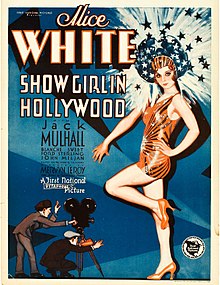Showgirl in Hollywood
| Show Girl In Hollywood | |
|---|---|
 | |
| Directed by | Mervyn LeRoy |
| Written by | Harvey F. Thew (adaptation) James A. Starr (adaptation) |
| Produced by | Robert North |
| Starring | Alice White Jack Mulhall Blanche Sweet Ford Sterling |
| Cinematography | Sol Polito |
| Edited by | Pete Fritch |
| Music by | Joseph Burke Ray Henderson |
Production company | |
| Distributed by | Warner Bros. |
Release date |
|
Running time | 80 mins. |
| Country | United States |
| Language | English |
Show Girl in Hollywood is a 1930 American Pre-Code all-talking musical comedy-drama film with Technicolor sequences, produced and distributed by First National Pictures, a subsidiary of Warner Bros. The film stars Alice White, Jack Mulhall and Blanche Sweet. It was adapted from the 1929 novel Hollywood Girl, by J. P. McEvoy.[1]
Al Jolson, Ruby Keeler, Noah Beery, Walter Pidgeon, and Loretta Young make cameo appearances in the final reel, which was photographed in Technicolor. Show Girl in Hollywood is a sequel to the 1928 Warner Bros. silent film Show Girl which also starred Alice White as Dixie Dugan.[1][2]
Synopsis
When the film begins, a musical show before closed down before it has had a chance to even open. Jimmie Doyle (Jack Mulhall), who wrote the musical intends to rewrite it while his girlfriend, Dixie Dugan (Alice White), fed up at wasting her time for a show that never even opened, is intent on finding a new career. While at a nightclub, Dixie does a musical number and catches the eye of Frank Buelow (John Miljan), a Hollywood director. Buelow persuades Dixie to go to Hollywood, where he will have a part waiting for her in his upcoming films.
Dixie takes the next train to California. When she arrives, she is disappointed to find that Buelow has been fired from the studio and that there is no part for her. Dixie meets Donny Harris (Blanche Sweet), a former star who is now out of work because she is considered "as old as the hills" at the age of 32.[3] Soon after, Dixie discovers that Jimmie Doyle is now in Hollywood because one of the movie studios had just bought the film rights to his musical play. Jimmie had insisted that Dixie be given the lead in the film version of his play. The film goes into production and Dixie manages to get Donny included in the cast. One day, Dixie meets Frank Buelow at a restaurant and tells her that he is now working for another studio. Through his influence, Buelow manages to change Dixie into a temperamental and conceited actress and this leads to complications which almost end her film career.
Cast
- Alice White - Dixie Dugan
- Jack Mulhall - Jimmy Doyle
- Blanche Sweet - Donny Harris, aka Mrs. Buelow
- Ford Sterling - Sam Otis, Film Producer
- John Miljan - Frank Buelow, a Director
- Virginia Sale - Miss J. Rule, Otis' Secretary
- Lee Shumway - Mr, Kramer
- Herman Bing - Bing, Assistant Director
Songs
- "I've Got My Eye on You"
- "Hang Onto a Rainbow"
- "There's a Tear for Every Smile in Hollywood"
- "Merrily We Roll Along"
- "Buy, Buy For Baby" (Or "Baby Will Bye Bye You")
Foreign language version
A French version of the film, titled Le masque d'Hollywood, and was directed by Clarence G. Badger and John Daumery.[4]
Reception
Show Girl in Hollywood received good reviews. Photoplay called the film Alice White's best talkie to date, and described it as "first-rate entertainment, in spite of a soggy spot or two."[5]
Preservation
The film only survives in a black and white copy only. The last reel was originally filmed in Technicolor but is now considered lost.
DVD release
Show Girl in Hollywood was released on DVD as part of the Warner Archive Collection in December 2009.[6]
See also
References
- ^ a b Bradley, Edwin M. (2004). The First Hollywood Musicals: A Critical Filmography of 171 Features, 1927 Through 1932. McFarland. p. 230. ISBN 0-786-42029-4.
- ^ Parish, James Robert; Pitts, Michael R.; Mank, Gregory W. (1978). Hollywood on Hollywood. Scarecrow Press. p. 315. ISBN 0-810-81164-2.
- ^ Bradley 2004 p.231
- ^ Liebman, Roy (2003). Vitaphone Films: A Catalogue of the Features and Shorts. McFarland. p. 209. ISBN 0-786-41279-8.
- ^ Kreuger, Miles ed. The Movie Musical from Vitaphone to 42nd Street as Reported in a Great Fan Magazine (New York: Dover Publications) p. 188. ISBN 0-486-23154-2
- ^ Kehr, Dave (January 15, 2010). "When Hollywood Learned to Talk, Sing and Dance". nytimes.com. Retrieved October 12, 2014.
External links
- 1930 films
- 1930s comedy-drama films
- 1930s musical films
- American comedy-drama films
- American films
- American musical films
- American black-and-white films
- English-language films
- Films about actors
- Films based on novels
- Films directed by Mervyn LeRoy
- Films made before the MPAA Production Code
- Films set in Los Angeles, California
- First National Pictures films
- Sequel films
- Warner Bros. films
